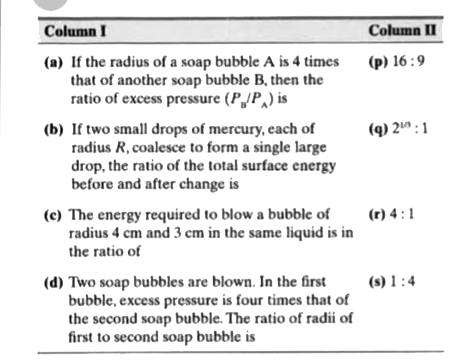Match the conditions/ expressions in Column I with statement in Column II

The correct Answer is:A→s,B→s,C→p,D→r
Step by step video & image solution for Match the conditions/ expressions in Column I with statement in Column II by Maths experts to help you in doubts & scoring excellent marks in Class 12 exams.
Updated on:21/07/2023Topper's Solved these Questions
- DEFINITE INTEGRALBOOK - ARIHANT MATHSCHAPTER - DEFINITE INTEGRALEXERCISE - Exercise (Single Integer Answer Type Questions)
5 Videos
- COORDINATE SYSTEM AND COORDINATES BOOK - ARIHANT MATHSCHAPTER - COORDINATE SYSTEM AND COORDINATES EXERCISE - Exercise (Questions Asked In Previous 13 Years Exam)
7 Videos
- DETERMINANTS BOOK - ARIHANT MATHSCHAPTER - DETERMINANTS EXERCISE - Exercise (Questions Asked In Previous 13 Years Exam)
18 Videos
Similar Questions
Match the conditions/ expressions in Column I with statements in Column II.
Let the functions defined in Column I have domain (−π/2,π/2).
(##41Y_SP_MATH_C10_E02_025_Q01.png" width="80%">
View SolutionMatch the conditions / expression in Column I with statement in Column II.

View SolutionMatch the conditions /expression n Column I with statement in Column II (z≠0 is a complex number )

View SolutionConsider the following linear equations
ax+by+cz=0
bx+cy+az=0
cx+ay+bz=0
Match the conditions/expressions in Column-I with statements in Column-II.

View SolutionMatch the conditions/expression in Column I With statement in Column II. Normals at P,Q,R are drawn to y2=4x which intersect at (3,0). Then,
column Icolumn IIA.Area ofΔPQRp.2B.Radius of circumcircle ofΔPQRq.52C.Centroid ofΔPQRr.(52,0)D.Circumcentre ofΔPQRs.(23,0)
View SolutionMatch the conditions/expressions in Column I with statement in Column Ⅱ. (A). sin(π[x]) (B) sin{π(x−[x])}
View SolutionMatch the reactions given in Column I with the statements given in Column II

View SolutionMatch the reactions given in Column I with the statements given in Column II

View SolutionMatch the reactions given in Column I with the statements given in Column II.

View SolutionMatch the statements in Column I with the statements in Column II . One or more than one choice from Column II can match with a statement from Column I.

View Solution
